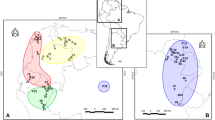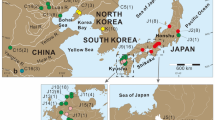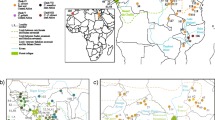Abstract
This study addresses for the first time the issue of pigeon (genus Columba) phylogeny within the archipelagos of Madeira (Columba trocaz) and Azores (C. palumbus azorica), located in the singular biogeographic area of Macaronesia. The phylogeny of these endemic pigeons was inferred based on mitochondrial (cytochrome b and cytochrome c oxidase I) and nuclear (β-fibrinogen intron 7) genetic markers through multiple approaches. Despite the non-monophyletic pattern for the insular endemic species recovered in the phylogenies, topology tests presented somewhat different results. C. trocaz, the Madeiran endemic species, clustered strongly with the Canarian endemic C. bollii, and these two are thus more closely related to each other than C. bollii to C. junoniae, the other endemic species of Canary Islands, which seems to have diverged independently. Moreover, C. trocaz was found to be phylogenetically closer to C. bollii than to C. palumbus from mainland Europe and Azores Islands. No genetic differentiation was found between the continental C. p. palumbus and the endemic C. p. azorica, which suggests a relatively recent colonisation event of the Azores Islands.
Zusammenfassung
Phylogenetische Ursprünge endemischer Taubenarten auf Madeira ( Columba trocaz ) und den Azoren ( Columba palumbus azorica )
Diese Studie untersucht erstmalig phylogenetische Fragen bei Tauben (Gattung Columba) auf den Inselgruppen Madeira (Columba trocaz) und Azoren (C. palumbus azorica) in der biogeografischen Region Makaronesien. Die Phylogenie dieser endemischen Taubenarten wurde mittels multipler Ansätze auf der Grundlage mitochondrialer (Cytochrom b und Cytochrom-c-Oxidase I) und nukleärer (β-Fibrinogen Intron 7) genetischer Marker rekonstruiert. Obwohl sich in den Phylogenien ein nicht-monophyletisches Muster für die endemischen Inselarten zeigte, führten die Topologie-Tests zu etwas abweichenden Ergebnissen. C. trocaz, die für Madeira endemische Art, war eng mit dem kanarischen Endemiten C. bollii gruppiert; somit sind diese beiden näher miteinander verwandt als C. bollii und C. junoniae, der anderen endemischen Art der Kanaren, welche sich unabhängig davon entwickelt zu haben scheint. Außerdem zeigte sich, dass C. trocaz phylogenetisch C. bollii näher steht als C. palumbus des Europäischen Festlandes und der Azoren. Es gab keine genetische Differenzierung zwischen der Festlandform C. p. palumbus und dem endemischen Taxon C. p. azorica, was für eine erst relativ kürzlich erfolgte Besiedlung der Azoren spricht.




Similar content being viewed by others
References
Adler GH, Austin CC, Dudley R (1995) Dispersal and speciation of skinks in the tropical Pacific Ocean among archipelagos. Evol Ecol 9:529–541
Bannerman DA (1963) Birds of the Atlantic Islands, vol 1. A history of the birds of the Canary Islands and of the Salvages. Oliver & Boyd. Edinburgh
Bannerman DA, Bannerman WM (1965) Birds of the Atlantic Islands, vol 2. A history of the birds of Madeira, the Desertas, and the Porto Santo Islands. Oliver & Boyd, Edinburgh
Bannerman DA, Bannerman WM (1966) Birds of the Atlantic Islands, vol 3. A history of the birds of the Azores. Oliver & Boyd, Edinburgh
Böhle UR, Hilger HH, Martin WF (1996) Island colonization and evolution of the insular woody habit in Echium L. (Boraginaceae). Proc Natl Acad Sci USA 93:11740–11745
Bramwell D (1972) Endemism in the flora of the Canary Islands. In: Valentine DH (ed) Taxonomy, phytogeography and evolution. Academic, London, pp 141–159
Brunton CFA, Hurst GDD (1998) Mitochondrial DNA phylogeny of Brimstone butterflies (genus Gonepteryx) from the Canary Islands and Madeira. Biol J Linn Soc 63:69–79
Cabral MJ, Almeida J, Almeida PR, Dellinger T, Almeida NF, Oliveira ME, Palmeirim J, Queiroz AI, Rogado L, Reis MS (2005) Livro Vermelho dos Vertebrados de Portugal. Instituto de Conservação da Natureza, Lisboa
Carine MA, Russell SJ, Santos-Guerra A, Francisco-Ortega J (2004) Relationships of the Macaronesian and Mediterranean floras: molecular evidence for multiple colonizations into Macaronesia and back-colonization of the continent in Convolvulus (Convolvulaceae). Am J Bot 91:1070–1085
Carracedo JC (1994) The Canary Islands: an example of structural control on the growth of large oceanic-island volcanoes. J Volcanol Geotherm Res 60:225–241
Carracedo JC, Pérez FJ, Ancochea E, Meco J, Hernán F, Cubas CR, Casillas R, Rodriguez E, Ahijado A (2002) Cenozoic volcanism II: the Canary Islands. In: Gibbons W, Moreno T (eds) The geology of Spain. Geological Society of London, London, pp 439–472
Carranza S, Arnold EN, Mateo JA, López-Jurado LF (2000) Long-distance colonization and radiation in gekkonid lizards, Tarentola (Reptilia: Gekkonidae), revealed by mitochondrial DNA sequences. Proc R Soc Lond B 267:637–649
Carranza S, Arnold EN, Mateo JA, López-Jurado LF (2001) Parallel gigantism and complex colonization patterns in the Cape Verde scincid lizards Mabuya and Macroscincus (Reptilia: Scincidae) revealed by mitochondrial DNA sequences. Proc R Soc Lond B 268:1595–1603
Clegg SM, Degnan SM, Kikkawa J, Moritz C, Estoup A, Owens IPF (2002) Genetic consequences of sequential founder events by an island-colonizing bird. Proc Natl Acad Sci USA 99:8127–8132
Coyne JA, Price TD (2000) Little evidence for sympatric speciation in islands birds. Evolution 54:2166–2171
Cramp S (ed) (1985) The Birds of the Western Palearctic, vol IV—Terns to Woodpeckers. Oxford University Press, New York
Dimitrov D, Arnedo MA, Ribera C (2008) Colonization and diversification of the spider genus Pholcus Walckenaer, 1805 (Araneae, Pholcidae) in the Macaronesian archipelagos: evidence for long-term occupancy yet rapid recent speciation. Mol Phylogenet Evol 48:596–614
Elias GL, Reino LM, Silva T, Tomé R, Geraldes P (1999) Atlas das Aves Invernantes do Baixo Alentejo. Sociedade Portuguesa para o Estudo das Aves, Lisboa, pp 234–235
Farris JS, Källersjö M, Kluge AG, Bult C (1995) Testing significance of incongruence. Cladistics 10:315–319
Felsenstein J (1988) Phylogenies from molecular sequences: inference and reliability. Annu Rev Genet 22:521–565
Fernández-Palacios JM, de Nascimento L, Otto R, Delgado JD, García-del-Rey E, Arévalo JR, Whittaker RJ (2011) A reconstruction of Palaeo-Macaronesia, with particular reference to the long-term biogeography of the Atlantic island laurel forests. J Biogeogr 38:226–246
Ferreira AB (2005) Geodinâmica e perigosidade natural das ilhas dos Açores. Finisterra XL 79:103–120
Francisco-Ortega J, Jansen RK, Santos-Guerra A (1996) Chloroplast DNA evidence of colonization, adaptive radiation, and hybridization in the evolution of the Macaronesian flora. Proc Natl Acad Sci USA 93:4085–4090
Francisco-Ortega J, Santos-Guerra A, Kim S-C, Crawford DJ (2000) Plant genetic diversity in the Canary Islands: a conservation perspective. Am J Bot 87:909–919
Gill FB (1995) Ornithology, 2nd edn. Freeman, New York
Gonzalez J, Castro GD, Garcia-del-Rey E, Bergerand C, Wink M (2009) Use of mitochondrial and nuclear genes to infer the origin of two endemic pigeons from the Canary Islands. J Ornithol 150:357–367
Grosso AR, Bastos-Silveira C, Coelho MM, Dias D (2006) Columba palumbus Cyt b-like Numt sequence: comparison with functional homologue and the use of universal primers. Folia Zool 55:131–144
Hafner MS, Sudman PD, Villablanca FX, Spradling TA, Demastes JW, Nadler SA (1994) Disparate rates of molecular evolution in cospeciating hosts and parasites. Science 2625:1087–1090
Hall TA (1999) BioEdit: a user-friendly biological sequence alignment editor and analysis program for Windows 95/98/NT. Nucleic Acids Symp Ser 41:95–98
Harshman J (1996) Phylogeny, evolutionary rates, and ducks. PhD dissertation, University of Chicago, Chicago
Hebert PDN, Stroeckle MY, Zemlak TS, Francis CM (2004) Identification of birds through DNA barcodes. PLoS Biol 2:1657–1663
Hernández MA, Martín A, Nogales M (1999) Breeding success and predation on artificial nest of the endemic pigeons Bolle’s Laurel Pigeon Columba bollii and White-tailed Laured Pigeon Columba junoniae in the laurel forest of Tenerife (Canary Islands). Ibis 141:52–59
Huelsenbeck JP, Larget B, Miller RE, Ronquist F (2002) Potential applications and pitfalls of Bayesian inference of phylogeny. Syst Biol 51:673–688
Johnson KP, Clayton DH (2000) Nuclear and mitochondrial genes contain similar phylogenetic signal for pigeons and doves (Aves: Columbiformes). Mol Phylogenet Evol 1:141–151
Johnson KP, de Kort S, Dinwoodey K, Mateman AC, ten Cate C, Lessells CM, Clayton DH (2001) A molecular phylogeny of the dove genera Streptopelia and Columba. Auk 118:874–887
Jordaens K, Van Riel P, Martins AMF, Backeljau T (2009) Speciation on the Azores islands: congruent patterns in shell morphology, genital anatomy, and molecular markers in endemic land snails (Gastropoda, Leptaxinae). Biol J Linn Soc 97:166–176
Jordall BH, Hewitt GM (2004) The origin and radiation of Macaronesian beetles breeding in Euphorbia: the relative importance of multiple data partitions and population sampling. Syst Biol 53:711–734
Juan C, Emerson BC, Oromí P, Hewitt GM (2000) Colonization and diversification: towards a phylogenetic synthesis for the Canary Islands. Trends Ecol Evol 15:104–109
Keogh JS, Edwards DL, Fisher RN, Harlow PS (2008) Molecular and morphological analysis of the critically endangered Fijian iguanas reveals cryptic diversity and a complex biogeographic history. Philos Trans R Soc Lond B 363:3413–3426
Kim S-C, McGowen MR, Lubinsky P, Barber JC, Mort ME, Santos-Guerra A (2008) Timing and tempo of early and successive adaptive radiations in Macaronesia. PLoS ONE 3:e2139
Kocher TD, Thomas WK, Meyer K, Edwards SV, Pääbo S, Villablanca FX, Wilson AC (1989) Dynamics of mitochondrial DNA evolution in animals: amplification and sequencing with conserved primers. Proc Natl Acad Sci 86:6196–6200
Marrero P (2009) Ecología trófica de las palomas endémicas de las Islas Canarias. PhD dissertation, University of La Laguna, Tenerife
Marrero P, Oliveira P, Nogales M (2004) Diet of the endemic Madeira Laurel Pigeon Columba trocaz in agricultural and forest areas: implications for conservation. Bird Conserv Int 14:165–172
Martín A, Hernández MA, Lorenzo JA, Nogales M, González C (2000) Las palomas endémicas de Canarias. Consejería de Política Territorial y Medio Ambiente del Gobierno de Canarias & SEO/BirdLife, Santa Cruz de Tenerife
Meik JM, Lawing AM, Pires-daSilva A (2010) Body Size Evolution in Insular Speckled Rattlesnakes (Viperidae: Crotalus mitchellii). PLoS ONE 5:e9524
Myers N, Mittermeier RA, Mittermeier CG, da Fonseca GAB, Kent J (2000) Biodiversity hotspots for conservation priorities. Nature 403:853–858
Nogales M, Marrero P, Padilla DP, Medina FM (2009) The study of habitat use by censuses and molecular methods in birds: the case of two sympatric pigeons. Bird Study 56:414–418
Nylander JAA (2004) MrModeltest v2. Program distributed by the author. Evolutionary Biology Centre, Uppsala University, Sweden
Nylander JAA, Ronquist F, Huelsenbeck JP, Nieves-Aldrey JL (2004) Bayesian phylogenetic analysis of combined data. Syst Biol 53:47–67
Oliveira P, Marrero P, Nogales M (2002) Diet of the endemic Madeira laurel pigeon and fruit resource availability: a study using microhistological analyses. Condor 104:811–822
Oliveira P, Menezes D, Jones M, Nogales M (2006) The influence of fruit abundance on the use of forest and cultivated field habitats by the endemic Madeira laurel pigeon Columba trocaz: Implications for conservation. Biol Conserv 130:538–548
Oromí P (2004) Biospeleology in Macaronesia. AMCS Bulletin 19/SMES Boletín 7:98–104
Pina-Martins F, Paulo OS (2008) Concatenator: sequence data matrices handling made easy. Mol Ecol Resour 8:1254–1255
Piñeiro R, Aguilar JF, de Sequeira MM, Feliner GN (2009) Low genetic diversity in the rare Madeiran endemic Armeria madeirensis (Plumbaginaceae). Folia Geobot 44:65–81
Posada D, Crandall KA (1998) MODELTEST: testing the model of DNA substitution. Bioinformatics 14:817–818
Prychitko TM, Moore WS (1997) The utility of DNA sequences of an intron from the beta-fibrinogen gene in phylogenetic analysis of woodpeckers (Aves: Picidae). Mol Phylogenet Evol 8:193–204
Rambaut A, Drummond AJ (2007) Tracer v1.4. http://beast.bio.ed.ac.uk/Tracer
Ribera I, Bilton DT, Vogler AP (2003) Mitochondrial DNA phylogeography and population history of Meladema diving beetles on the Atlantic Islands and in the Mediterranean basin (Coleoptera, Dytiscidae). Mol Ecol 12:153–167
Ronquist F, Huelsenbeck JP (2003) MrBayes 3: Bayesian phylogenetic inference under mixed models. Bioinformatics 19:1572–1574
Rubinoff D (2008) Phylogeography and ecology of an endemic radiation of Hawaiian aquatic case-bearing moths (Hyposmocoma: Cosmopterigidae). Philos Trans R Soc Lond B 363:3459–3465
Russell GJ, Diamond JM, Reed TM, Pimm SL (2006) Breeding birds on small islands: island biogeography or optimal foraging? J Anim Ecol 75:324–339
Sambrook J, Fritsch EF, Maniatis T (1989) Molecular cloning: a laboratory manual, 2nd edn. Cold Spring Harbor Laboratory Press, New York
Sá-Pinto A, Branco M, Sayanda D, Alexandrino P (2008) Patterns of colonization, evolution and gene flow in species of the genus Patella in the Macaronesian Islands. Mol Ecol 17:519–532
Schmitz P, Cibois A, Landry B (2008) Cryptic differentiation in the endemic micromoth Galagete darwini (Lepidoptera, Autostichidae) on Galápagos volcanoes. Philos Trans R Soc Lond B 363:3453–3458
Shimodaira H, Hasegawa M (1999) Multiple comparisons of log- likelihoods with applications to phylogenetic inference. Mol Biol Evol 16:1114–1116
Sorenson MD, Ast JC, Dimcheff DE, Yuri T, Mindell DP (1999) Primers for a PCR-based approach to mitochondrial genome sequencing in birds and other vertebrates. Mol Phylogenet Evol 12:105–114
Sota T, Nagata N (2008) Diversification in a fluctuating island setting: rapid radiation of Ohomopterus ground beetles in the Japanese Islands. Philos Trans R Soc Lond B 363:3377–3390
Stephens M, Scheet P (2005) Accounting for decay of linkage disequilibrium in haplotype inference and missing data imputation. Am J Hum Genet 76:449–462
Stephens M, Smith NJ, Donnelly P (2001) A new statistical method for haplotype reconstruction from population data. Am J Hum Genet 68:978–989
Stracey CM, Pimm SL (2009) Testing island biogeography theory with visitation rates of birds to British islands. J Biogeogr 36:1532–1539
Stresemann E (1927–1934) Aves. In: Kükenthal W, Krumbach T (eds) Handbuch der Zoologie. Walter de Gruyter, Berlin
Su YCF, Saunders RMK (2009) Evolutionary divergence times in the Annonaceae: evidence of a late Miocene origin of Pseuduvaria in Sundaland with subsequent diversification in New Guinea. BMC Evol Biol 9:153
Swofford DL (2002) PAUP*: phylogenetic analysis using parsimony (* and other methods), version 4.0b10. Sinauer Associates, Sunderland
Thompson JD, Gibson TJ, Plewniak F, Jeanmougin F, Higgins DG (1997) The CLUSTAL-X windows interface: flexible strategies for multiple sequence alignment aided by quality analysis tools. Nucleic Acids Res 25:4876–4882
Thorpe RS, Surget-Groba YS, Johansson H (2010) Genetic tests for ecological and allopatric speciation in anoles on an island archipelago. PLoS Genet 6:e1000929
Van Riel P, Jordaens K, Van Houtte N, Martins AMF, Verhagen R, Backeljau T (2005) Molecular systematics of the endemic Leptaxini (Gastropoda: Pulmonata) on the Azores islands. Mol Phylogenet Evol 37:132–143
Vargas P, Morton CM, Jury SL (1999) Biogeographic patterns in Mediterranean and Macaronesian species of Saxifraga (Saxifragaceae) inferred from phylogenetic analyses of ITS sequences. Am J Bot 86:724–734
Villacorta C, Jaume D, Oromí P, Juan C (2008) Under the volcano: phylogeography and evolution of the cave-dwelling Palmorchestia hypogaea (Amphipoda, Crustacea) at La Palma (Canary Islands). BMC Biol 6:7
Warren BH, Bermingham E, Bowie RCK, Prys-Jones RP, Thébaude C (2003) Molecular phylogeography reveals island colonization history and diversification of western Indian Ocean sunbirds (Nectarinia: Nectariniidae). Mol Phylogenet Evol 29:67–85
Whittaker RJ, Fernández-Palacios JM (2007) Island bio- geography: ecology, evolution, and conservation, 2nd edn. Oxford University Press, Oxford
Acknowledgments
We are grateful to Dr. J. Faustino (Direcção Geral dos Recursos Florestais, Portugal), Prof. José Madeira (Faculdade de Ciências da Universidade de Lisboa, Portugal), Conseil Régional de La Chasse d’Aquitaine (France) and Federación Guipuzcoana de Caza (Spain) for providing biological samples for this study. We would like to thank the two anonymous reviewers for providing useful comments on the manuscript. Margarida Alexandra Duarte participation was supported by a PhD grant FCT (SFRH/BD/70646/2010), Patricia Marrero was supported by a postdoctoral grant of the Spanish Minister of Education, Cristiane Bastos-Silveira was supported by a postdoctoral grant FCT (SFRH/BPD/26612/2005) and Octávio S. Paulo was supported by the grant FCT and FEDER (POCTI/BSE/48365/2002).
Author information
Authors and Affiliations
Corresponding author
Additional information
Communicated by M. Wink.
Electronic supplementary material
Below is the link to the electronic supplementary material.
Rights and permissions
About this article
Cite this article
Dourado, C.G., Duarte, M.A., Grosso, A.R. et al. Phylogenetic origin of the endemic pigeons from Madeira (Columba trocaz) and Azores Islands (Columba palumbus azorica). J Ornithol 155, 71–82 (2014). https://doi.org/10.1007/s10336-013-0988-6
Received:
Revised:
Accepted:
Published:
Issue Date:
DOI: https://doi.org/10.1007/s10336-013-0988-6




